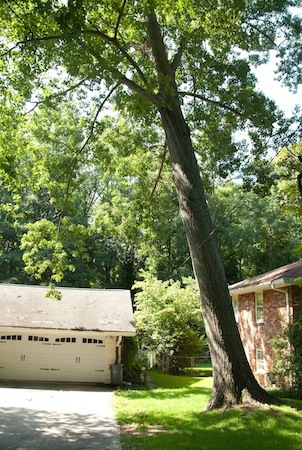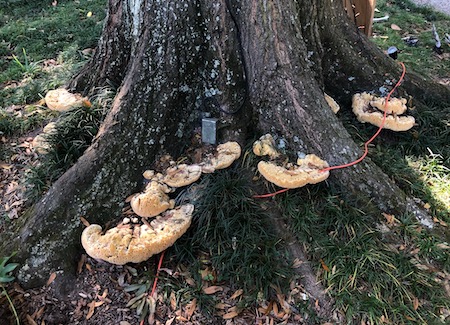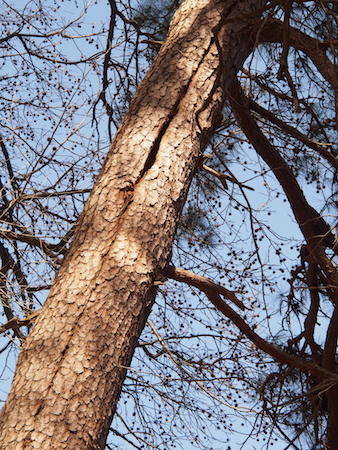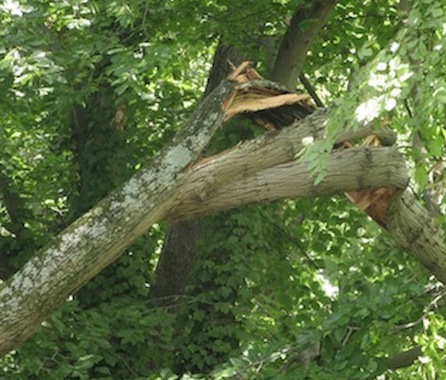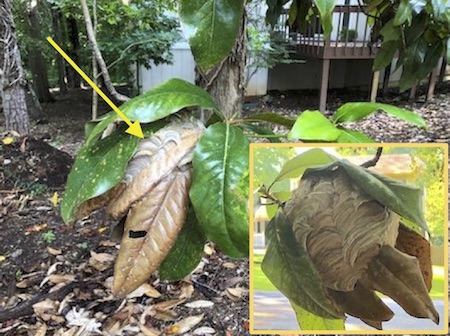
Our article, "Reading a Tree for Risks and Hazards," shows some of the more obvious signs of a tree with problems. These are easy to understand and can be seen with the naked eye. Some conditions we describe indicate that your tree has a problem that should addressed by a professional arborist immediately. We also show you some trees where the "problems" aren't problems at all, but rather normal and natural occurrences that don't pose a threat to the tree.
We chose our pictures carefully to help you understand what we're talking about. Click on the dots below the images to see all the pictures in each section.
Caution! Do not substitute this short article for getting the opinion of a professional! An experienced certified arborist can spot trouble that the untrained eye will not see, and can give you advice that goes well beyond the scope of our article and, probably, your own knowledge.
How to Inspect Your Tree(s) Using the “Four Zone Approach”
To inspect a tree thoroughly, examine all four of its "zones":
Zone 1: The tree as a whole, seen from a distance;
Zone 2: The ground, including the visible roots and ground around them, and the first three feet of the trunk;
Zone 3: The trunk -- the main vertical stem(s) of the tree;
Zone 4: The crown -- the branches and leaves, including where the branches connect to the trunk, and each branch all the way out to its tips.
Zone 1: The tree as a whole
From a place where you can see the whole tree at one time, take a long look. Focus on the entire tree rather than its individual parts.
- Is the tree leaning? What is it leaning toward (the "target")? Has this lean been there for a long time? Is it leaning more than it was a day, week, or month ago? Is the tree leaning in an easterly direction? Trees that lean toward the east are more vulnerable to falling because most of the winds come from the west.
- Can you see any big dead branches? Are there a lot of dead branches, or just a few? Are they on the lower part of the tree, or only on one side of the tree?
- Are there sections of the tree where there are no leaves at all? Does the tree have a thin leaf cover? Are the leaves dropping much earlier than from other trees of the same species nearby? Do the fallen leaves look unusual?
- Are the branches dying back at the tips?
If the answer is “yes” to any of these questions, your tree may be in the process of falling over, sick, imbalanced, or dying. Get the tree evaluated immediately by a Certified Arborist. Better to be safe than sorry.
Zone 2: The ground, including any visible roots and the first three feet up the trunk
There are two types of tree roots. The most visible are the large anchoring (structural) roots, which hold up the tree. The smaller and invisible absorbing roots provide the tree with water and nutrients from the soil. Even a tree that appears strong and vibrant with foliage can have serious root problems. Examine the base of the trunk and the ground around the bottom of a tree. It’s here that you may find your first evidence of root problems or other hazards.
- Pull back any ivy, mulch, or ground cover (watch out for poison ivy!) and look closely where the trunk meets the ground. If you see cracked or raised soil, the tree may be in the process of uprooting.
- Do you see fungus (mushrooms) on or near the tree's roots or trunk? Fungus is a strong indicator of root or trunk decay. And when a tree’s anchoring roots are rotting, decayed, or cut, the tree is at risk of falling over. If too much of the trunk is decayed, it can buckle or break.
Uprooting, root rot, and decay at the base of a tree can be very dangerous situations which require immediate attention. Call a Certified Arborist to help you determine whether the tree needs to be removed or whether it's safe to leave it standing.
Other things to look for in your Zone 2 inspection:
- Deep cavities (openings in the tree) near the ground are a bad sign. The tree could collapse if the trunk is missing too much wood at its base.
- Are there dead branches on the ground? If so, there will likely be more up in the tree, especially if your tree has never been cleaned out by a tree care professional. Hesitate before you walk under the tree if the ground is littered with dead branches. An arborist will usually spot dead branches you didn’t notice.
- Do you see coarse or fine sawdust (also called "frass") on the trunk or at the base of a tree? If so, the tree is getting attacked by borers (small beetles). A borer invasion will usually kill the tree. However, in some species it may be possible to save the tree if the insects are caught and treated early on. When you see frass, call a Certified Arborist immediately to find out why it's there and what it means for your tree.
- Do you see carpenter ants or termites at the base or on the lower trunk of your tree? Both of these insects only nest in wood that is already dead, so they are good indicators that there may be a problem inside the tree. Carpenter ants are usually seen on the outside of the trunk on the ground leading to the tree. Termites are difficult to spot because they die from the heat of sunlight, so they stay hidden underneath dead bark.
- Raised sections or cracks in the driveway or sidewalk caused by a tree's roots pose a risk to pedestrians. These need to be repaired so people don't trip or fall. Consult a Certified Arborist to learn how you can save your tree's roots while addressing the problem.
Zone 3: The trunk
The trunk holds up the tree and supports the massive weight of its branches. Inspect the trunk thoroughly.
- Cavities can be dangerous, depending on their size, where they're located on the tree, and how deep they are. If there is a cavity above eye level, a "climbing" (aerial) inspection may be needed to find out how deep it is and if there is decay.
- Cracks and splits in the trunk are extremely dangerous. If there is a crack or split in the trunk, the entire tree could fall or break apart at any time.
- Missing bark (or areas where bark is falling off) usually signals a dead section. Look for places on the tree’s trunk where there is no bark, the bark is falling off, or the bark is discolored. Missing bark can also indicate a surface wound, infection, or a fungus attack.
- When ants and beetles attack a tree, they leave very fine, light-colored sawdust (“frass”) that is easy to see. Ants cutting into decayed wood leave coarse shavings. Pine bark beetles attacking a pine tree leave “pitch tubes” that resemble marble-sized balls of light-colored sap.
- A long streak of missing bark coming down the tree usually means the tree was struck by lightning. It's possible that a tree can recover from this, but if the leaves or needles turn brown after several weeks, the tree has died. Call a Certified Arborist immediately if lightning has struck a pine tree near the home. Pine bark beetles can smell oozing sap from miles away. Spraying the tree will help deter an attack, which will certainly kill the tree if the lightning didn't.
- Trees with 2 or more trunks sometimes crack and split where the trunks connect. Strong connections appear as a “U” shape; weak connections resemble a tight “V” shape. Sometimes a tree adds layers of wood over the trunk connection to strengthen a crack. After a windstorm, look at the connection in the tree where the trunks meet. Use binoculars if the connection is high up. If there is a lightly colored line that contrasts to the natural dark bark color, you are probably looking at a fresh crack. The tree may be in the process of splitting apart. Consider this situation an emergency.
If you see any of the above conditions in your tree, call a Certified Arborist immediately to determine if your tree is stable enough to leave standing or whether it should be removed.
Zone 4: The crown
The crown includes the leaves and all the branches that extend out from the trunk.
One of the most common and obvious dangers in a tree's crown is dead wood. Dead branches are easy to spot in a hardwood tree. If the rest of the tree still has green leaves, the dead branches are the ones with brown leaves or no leaves at all. A pine branch that has recently died will have brown needles; if it's been dead for a long time, it won't have any needles.
Branches that have been dead for a while won’t have any bark on them. These dead branches break easily. They should be removed carefully so they don't fall on someone or something. A hardwood tree that has many brown leaves on it in winter is probably dead (except for American beech trees, which hold on to their dead leaves until early spring.)
Look for broken branches, especially after a strong storm. On some trees you may not know that a branch is broken until about a month later, when the leaves turn brown.
Pockets of decay or rot sometimes exist on the upper side of a branch, where they are invisible to a ground observer. The arborist may need to climb the tree to check. This is especially true when there are large branches that extend over the house.
SUMMARY
Be proactive. Follow the guidelines below to protect yourself, your family, and your home.
- Inspect your trees often!
- Get your trees checked immediately if you see -- or think you see -- any of the warning signs mentioned in our four-zone inspection.
- A Certified Arborist should check large trees regularly, every three years at a minimum.
- Get your trees checked more frequently during extreme weather cycles, such as long periods of excessive rainfall or drought.
- Look at your trees after serious weather events, such as a very strong wind, overly excessive rain, or an ice storm. When you walk around your house, look carefully at your roof, too. Roof punctures caused by falling branches can lead to terrible water damage inside your home.
- Get your trees pruned by a professional arborist to remove any weak, broken, cracked, or dead branches. Have this done at least every three years or when you notice them. This will help keep your trees safe, healthy, and beautiful. And remember--leg spikes should never be used to climb a tree to prune it!

